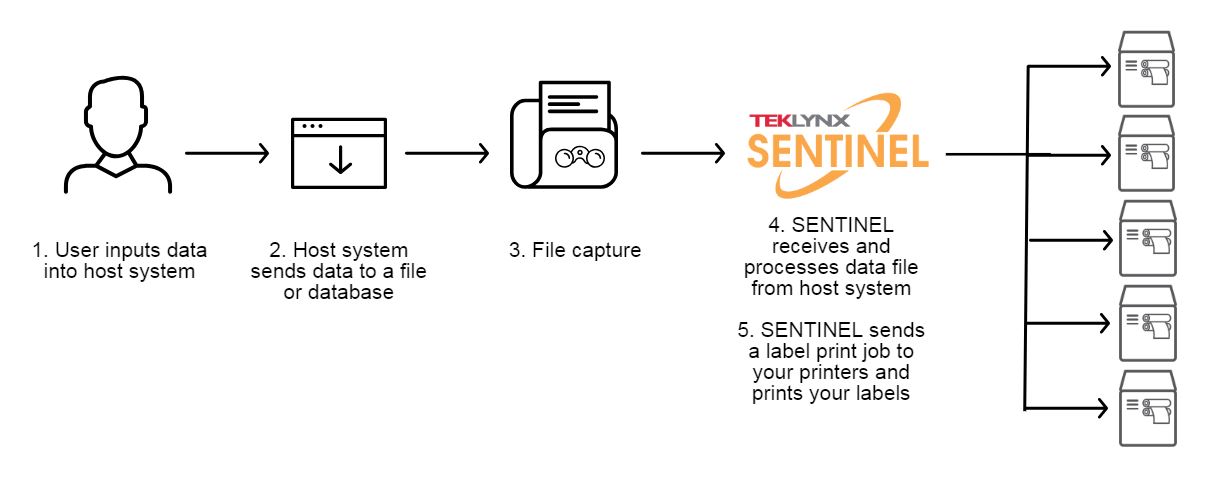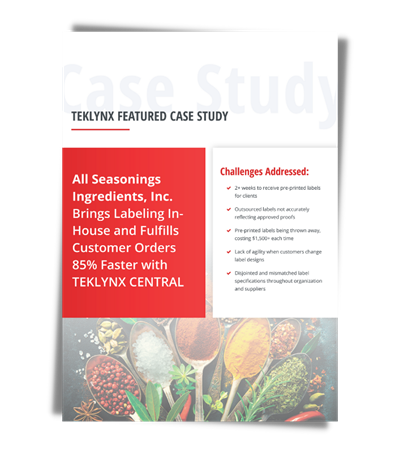Partner Blog By: DOUG NIEMEYER/TEKLYNX
Originally appeared on The Human Readable Blog, by TEKLYNX.
Between the transformation of production and the challenges presented by COVID-19, the manufacturing industry has undergone a lot of changes in 2021. Workforce shortages and supply chain instability are causing a decline in operational efficiency and margins, and businesses are looking for ways to recoup costs from the global pandemic.
Looking forward, business agility and technology adoption is even more critical for organizations to operate through the turbulence from an unusually quick economic rebound and to compete in the next growth period. This blog will explain four trends in the manufacturing industry and how labeling will support those trends through 2022 and beyond so you can set your company up for success.
If you’re unsure where to start with labeling, get in touch with a TEKLYNX expert to assess your current environment and help you find the best barcode labeling software solution to fit your business.
Worker Shortage Drives Demand for Automation Technology & Creating Efficient Workflows
Automation is vital in helping manufacturers compensate for a worker shortage and eliminate time-consuming and error-prone processes. Leveraging automation technology, along with mobile device management solutions, ensures that operations remain efficient and secure, enabling teams to monitor and control devices used on the production floor. This approach also sustains the need to continually improve operations to support e-commerce and an industry shift from B2B to B2C.
By automating labeling processes, companies can easily make their workflows faster and more efficient, enabling them to do more with less. When paired with RFID technology, automation can also improve accuracy, reduce errors, and provide real-time visibility across operations.
BENEFITS OF AUTOMATIC LABEL PRINTING:
- Eliminate manual processes: Save time and prevent errors by reducing manual processes.
- Reduce IT interaction: Once label printing automation software is configured with your system, little to no maintenance is required.
- Faster label printing: Through the elimination of manual data entry and business system integration, your label printing process speed could double.
- Convert data to labels: Label printing automation software automatically populates the labels for you by pulling the data directly from your business system, eliminating manual data entry.
- Integrate with business systems: Connect label automation software with your existing on-premise or cloud-based ERP, WMS, or custom business system.
- Ensure label accuracy: Automating your label printing process reduces human interactions which requires fewer people and decreases the opportunity for error.
- More user-friendly label printing process: Eliminating unnecessary steps in your labeling environment to create a simpler process for your print users, reducing stress and saving time.

Avoiding Downtime Increases Need for Planned Maintenance & Support
According to Gartner, the average cost of IT downtime is $5,600 per minute, and 98% of organizations say a single hour of downtime costs over $100,000. Planned maintenance or software upgrades gives manufacturers the opportunity to schedule downtime around their own production schedules.
Also, according to Identity Theft Resource Center (ITRC) research, the total number of data breaches through September 30, 2021, has already exceeded the total number of events in 2020 by 17%, with 1,291 breaches in 2021 compared to 1,108 breaches in 2020. This puts additional pressure on IT teams to ensure all applications are secure, backup or disaster recovery plans are documented, and software is protected under maintenance agreements or technical support.
We highly recommend companies stay on the most current version of their barcode labeling software to avoid the risk of production downtime and ensure compatibility with new technology. Subscription-based licensing includes priority technical support and free version upgrades, ensuring you always have access to the most up-to-date software and can upgrade at a planned time.
Plus, enterprise label management solutions have evolved to include automatic back-up server functions, so if your primary server shuts down, your secondary server automatically becomes the primary server. Once your primary server is up and running, the secondary server switches to back-up, so downtime in your labeling process is one less thing to worry about.
See how Dot Foods leverages CODESOFT and SENTINEL to meet their internal labeling security requirements to maintain a high availability – or always on – manufacturing environment.
Industry 4.0 Accelerates Digital Technology Adoption
Industry 4.0 – shorthand for the fourth industrial revolution – describes the trend towards smart factories in manufacturing. Gartner defines smart factories as a concept to describe the application of different combinations of modern technologies to create a hyperflexible, self-adapting manufacturing capability. Smart factories are an opportunity to create new forms of efficiency and flexibility by connecting different processes, information streams, and stakeholders in a streamlined fashion.
This conceptualizes the rapid change in technology and processes due to increasing interconnectivity and automation within manufacturing. Foundational technology such as cloud computing enables increased visibility, scale, and speed – making Industry 4.0 possible.
Cloud-ready and centralized enterprise label management solutions allow companies to handle label design, approval, printing, and reporting from a single location. Companies are adopting and seeing results from more connected, reliable, efficient, and predictive processes.
Environmental Responsibility Brings More Resources & Rigor to Advancing Sustainability
Managing operations in a sustainable and environmentally responsible manner is now a business imperative across the manufacturing industry. Companies require more traceability and visibility into where products go and product use to measure the impact on the environment and eliminate waste.
Tracking products throughout the supply chain starts with a barcode. GS1 standards provide the framework for real-time tracking, traceability, and supply chain efficiencies. It’s the global language of business between your suppliers, partners, and customers. Creating GS1 barcodes efficiently and accurately is crucial for day-to-day operations of businesses around the globe.
Fun fact: According to GS1, the retail industry is embarking on one of the biggest changes since the original introduction of the barcode – adoption of two-dimensional (2D) barcodes to enhance the experiences of consumers, brands, retailers, and everyone in between. Learn more.

WITH THE IMPLEMENTATION OF TEKLYNX CENTRAL, ALL SEASONINGS INGREDIENTS, INC.:
- Fulfills orders 85% faster with an in-house solution
- Eliminated pre-printed labels from going unused
- Increased customer satisfaction
- Integrated with their ERP system for inventory control
- Made label printing available from multiple areas of the building
- Leverages uniform labels throughout their supply chain for 1,000+ products
Read the full case study. Also, our eBook, Achieving Lean Labeling Success, provides strategies to help you use lean labeling to reduce waste, increase efficiency, and grow your bottom line.
Set Your Company Up for Success
TEKLYNX has over 30 years of experience helping companies around the word build efficient and effective labeling environments. We understand every industry and business is different and have their own unique labeling challenges or goals.
Let TEKLYNX assess your current labeling process for improvements – such as automatic label printing or centralization of label management – so your labeling environment is stable and agile enough to change with industry trends through 2022 and beyond.
###


